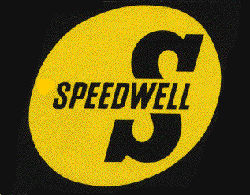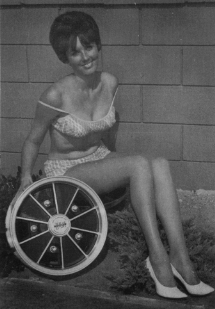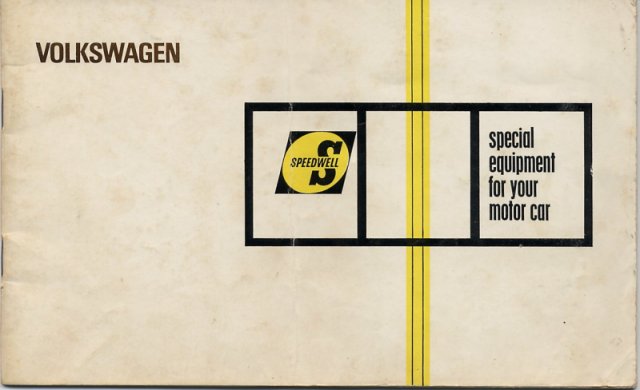The name EMPI is synonymous with the early days of VW tuning in the USA and its links with the British Speedwell organisation have caused Volkswagen enthusiasts the world over to suddenly take an interest in this long-lost company. However, few people are aware of how the Speedwell story began and how the company came to be involved with the VW performance industry back in the 1960s. Want to know more? Read on.
The tale begins in the most unlikely of places: an espresso bar in north London. Espresso bars were the centre of the social life of many young people in the late fifties and early sixties, being in many ways the equivalent of a wine bar today — except they sold warm, frothy coffee from an espresso machine, rather than alcohol. A young motorsport enthusiast by the name of John Sprinzel used to frequent the espresso bar and there met George Hulbert, a fellow enthusiast who offered to do some cylinder head work on Sprinzel's Austin A35. The result was a car so much improved that it won its first outing at Goodwood race circuit on Whit Monday, in 1957. The ensuing media coverage led to a deluge of letters from other enthusiasts, all wanting to know about these cylinder head conversions.
Following this, Hulbert and Sprinzel discussed the idea of forming a company to cater for this potential market. As it happens, another regular at the coffee bar was a person by the name of Len Adams who was also a motorsport fan. He was soon overwhelmed by the prospect of being involved with a tuning company and joined in the discussions. A fourth person, Reg Venner, was employed as the mechanic, while a budding racing driver-cum-mechanic, by the name of Graham Hill, became workshop foreman. Thus, on 26th June 1957, Speedwell Performance Conversions was born, the name being derived from that of the local telephone exchange at Golders Green.
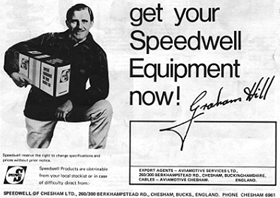
This enthusiastic team was soon joined by a secretary, Ann Wisdom, who herself was to gain notoriety in later years as a successful navigator to Pat Moss, the sister of Stirling, in international rallying. The company's office was initially located in John Sprinzel's flat at 7 Accommodation Road, Golders Green, but later moved to 763d Llanvanor Road when it became obvious more space was needed. Eventually, as business began to boom, Speedwell acquired the premises next door, and then next door to that, ultimately owning a string of properties, including a shop on the corner of Finchley Road. By now, the team had become pretty organised, with Reg Venner and Graham Hill carrying out the conversion work, Len Adams looking after the sales, George Hulbert doing the development work and John Sprinzel handling the day to day running.
A year later, they were joined by a Swede, Lutz Arnstein whose forté was selling. He became responsible for much of Speedwell's export success and ultimately took over the running of the company when Sprinzel left to go it alone in 1959. By the time the new decade began, the team had been joined by David Jones, who carried out much of the development work, and Peter Latina, who assembled the engines. A move to new premises in Cornwall Avenue, north London, gave Speedwell the room it needed to expand further, with a purpose-built engine test room, complete with Heenan and Froude dynamometer, giving the company the opportunity to further develop a line of performance equipment.
At this time, the product range consisted largely of modified cylinder heads and carburettor conversions for a variety of British cars, including the Austin A35, the Mini, MG Midget, Austin Healey Sprite, Riley 1.5 and the Wolseley 1500. Thanks largely to Lutz Arnstein's input, Speedwell also marketed some parts for the Saab. In 1962, Speedwell added a clever little suspension component to its product line: the camber compensator. Designed by Joe Vittone of EMPI, the compensator had been developed originally for use on the race-winning Inch Pincher Beetle driven to glory by Dan Gurney.
However, the relationship between EMPI and Speedwell was not to be formalised for another three years when, in November 1965, a copy of the Speedwell News announced that the two companies were 'linking services to offer the largest and most comprehensive Volkswagen range of modifications in the world'. The agreement was that Speedwell should look after sales of EMPI products in the UK and Europe, while EMPI would take care of America and the rest of the world, thus opening the doors for the Speedwell range to be sold into the potentially lucrative north American market. This marked the first time that anyone had seriously tried to market any Volkswagen performance parts in the UK. Earlier, in September that year, Speedwell had attended the 2nd National VW Convention held at Stanford Hall where the prize of a new camber compensator created much interest.
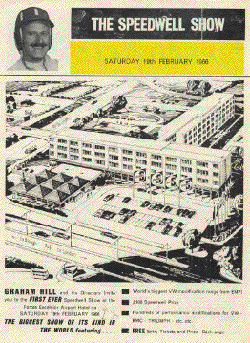
On Saturday 6th February, 1966, Speedwell organised its own show at the Excelsior Hotel, close to London's Heathrow airport. On display was an impressive range of cars, including two Volkswagens, and variety of Speedwell equipment, which included a VW engine fitted with an EMPI extractor exhaust system and carried on an EMPI Motor Porter trolley.
At least one of the cars, and the engine on the trolley, was fitted with the EMPI/Speedwell Sprint carburettor kit, which consisted of a pair of Stromberg CD150 constant vacuum carbs on cast manifolds with a substantial throttle linkage which was not at all unlike that offered by Gene Berg to this day. A remote oil cooler was mounted at the rear of the engine, covering the air intake for the cooling fan. This kit was to prove a sales success on both sides of the Atlantic, although it is rarely seen today, and was claimed to boost power output by 10%. The cost? Just £35! EMPI's own Zenith VW single carburettor kit was also offered by Speedwell, this consisting of a 32NDIX carb with a matching manifold, filter and an all-centrifugal distributor. This kit was more expensive at £58.
The company developed a range of gauges for use in all cars, the rev counter (£10/15s - that's £10.75p) in particular being a much-praised item. With purpose-made mounting panels to allow them to be fitted in place of the speaker grills on a right- or left-hand drive Beetles (these cost £1/7s/6d, or £1.38p each), the gauges became a popular addition on many cars. A Speedwell steering wheel (at £7/19s/6d or £7.98p) was also marketed and, while not as elegant as the contemporary EMPI GT wheel, has become sought after today.

Without doubt, the best-known joint venture between EMPI and Speedwell was the BRM wheel. Cast by the Rubery Owen organisation from almost pure magnesium, they were claimed to be some 40% lighter than the original steel wheel, stronger and wider, with a rim width of 5ins. Announced in January 1966, the wheels were first seen by the public at the end of February and would soon become a big seller in the USA where the benefit of light weight was not lost on the drag race fraternity.
Although several examples of the wheel were undoubtedly sold in the UK and Europe (nobody knows for sure how many were actually made), they have proved to be virtually unobtainable in recent times, with most known examples having been imported from the USA at great cost. Originally they sold for just £14/10s (£14.50p) each! Or you could splash out and buy five at the bargain price of £69/10s (£69.50p), thus saving £3.00. Amazingly enough, chromed Porsche 356-style wheels were only £3.00 cheaper than the BRMs.
The Speedwell range was fairly limited as far as dedicated parts for the VW was concerned, consisting largely of the two carburettor kits, camber compensator, valve guides and road wheels. Most other components, such as the gauges, steering wheel and door mirrors were designed to be used on a wide range of vehicles - the Mini was by far the most important car as far as Speedwell was concerned, with most of the development work being carried out in that direction (sad, but true!).
By the end of the 1960s, Speedwell as we know it had all but disappeared, along with so many other well-established British tuning companies. Changing attitudes, cheap imports, better cars available in the showroom - all conspired to tap the nails into the coffin of the industry. Today, however, Speedwell lives on in spirit and the name is beginning to capture the imagination of a whole new audience which is gradually becoming aware that, once upon a time, this country had very close ties to the late, great EMPI.
